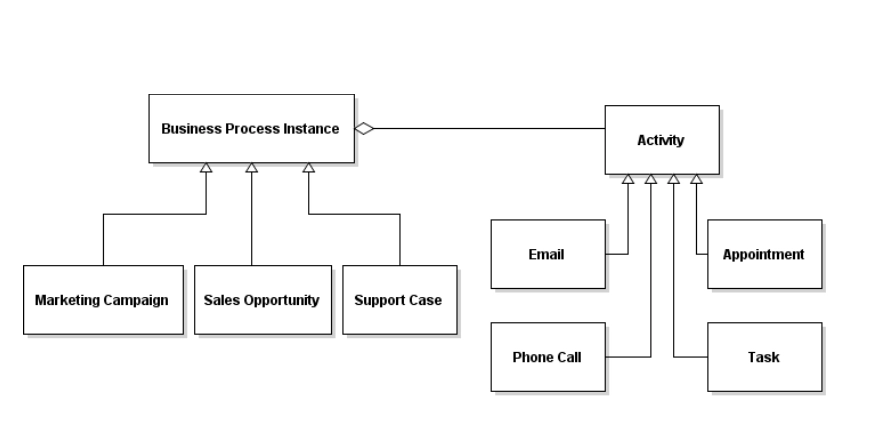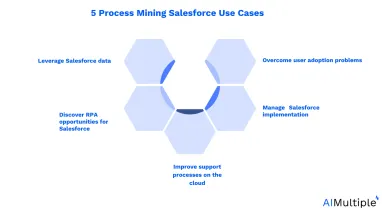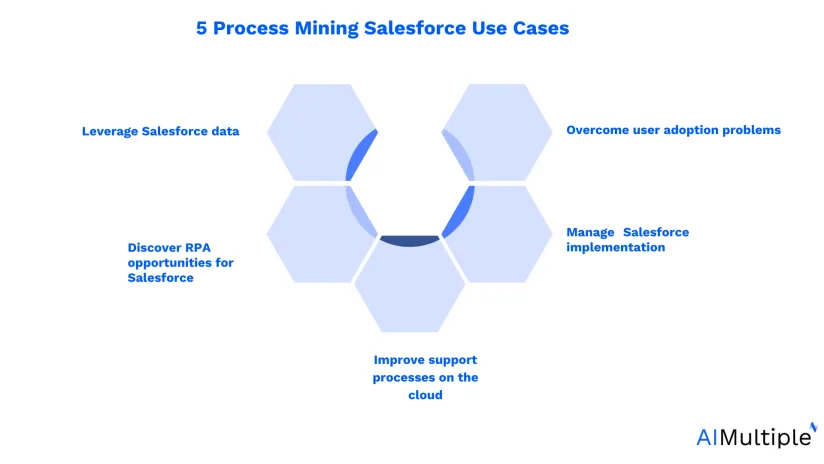Salesforce is one of the leading CRM software and enterprise cloud systems helping businesses with account management, customer service and marketing. Yet, Salesforce poses certain challenges, such as user adoption problems or management issues. The software might require further integration to RPA bots or analytics tools to automate the manual activities or to clean and analyze the excessive event logs data.
Process mining salesforce can overcome the mentioned challenges and serve as an analytical tool that discovers the data and offers insights on automation opportunities.
In this article, we cover 5 use cases where sales leaders can deploy process mining in Salesforce to improve customer service and increase sales velocity.
1. Salesforce data
Salesforce CRM tracks all customer interactions, including orders, support cases, and sales activities. This provides valuable data for customer service improvement. However, the data’s mixed structured and unstructured formats complicate cleaning and analysis.
Figure 1: CRM data model

Process mining can be helpful to leverage such data to analyze and visualize real-time sales processes to obtain insights into inefficiencies and the points where the deals are stuck. Specifically, leading process mining vendors employ process mining algorithms to automatically gather, transform and discover the data by labeling activities and discovering event classes.
By deploying process mining in Salesforce, sales teams and business analysts can monitor sales processes, set standard or ideal business processes, improve sales performance and conversion rate, and develop and optimize marketing strategies.
Explore more how process mining supports sales and marketing to accelerate.
Real-life example
Safeway, a global retailer, faced unpredictability in seasonal promotion performance and difficulties analyzing past campaigns using traditional Salesforce analytics. Safeway implemented intelligent process mining on Salesforce data to enhance promotional campaign planning and execution.
Results they achieved:
- Achieved a 400% increase in efficiently analyzed processes.
- Reduced campaign planning times by up to 92%.
- Enhanced collaboration across supplier, store, and marketing teams through improved visibility into past performance patterns.1
2. RPA opportunities for Salesforce
Salesforce can include time-consuming manual activities such as exchanging data between Salesforce and third-party platforms such as business ERP systems. By integrating Salesforce with an RPA solution, businesses can automate these manual activities and increase operational efficiency of the platform. However, it is still a challenge to detect which activities could be automated and manage the automation initiative.
Process mining can help IT and sales teams catch the inputs that require an urgent automation implication. Executives can utilize process mining to manage RPA integration process itself and track the changes after having implemented them. Learn more on ways process mining facilitates RPA deployment.
For example, a business that wants to analyze the customer journey for their new product needs to gather the data from business web portal, CRM and ERP systems. The business can benefit from RPA bots to automatically extract relevant process data from these portals. Check out Robotic process automation use cases for more applications.
Some process mining vendors offers digital twin of an organization (DTO), which is a specific application of digital twins that enables process simulation to obtain an accurate view of current automation project.
Real-life example
Dell, a multinational technology company, lacked visibility into their complex deal registration processes within Salesforce, hindering performance tracking and SLA enforcement. Dell implemented Celonis to differentiate and analyze one-step and two-step deal registration processes, identifying opportunities for automation.
Results they obtained include:
- Automated nearly 15% of deal processing by the end of 2020.
- Enabled responses to partners within 15 minutes of deal registration.
- Provided sales operations with clear visibility into active deals and KPIs through analytics scorecards.2
3. Improve support processes
Support processes are the secondary business processes that streamline the operational workflow or case resolution. Salesforce allows sales and marketing executives to generate support process cycles and control the steps users follow during the case resolution.
Process mining can identify such cases where support processes are needed. By implementing process mining in front-and back-office systems in Salesforce, sales executives can evaluate their core sales and revenue metrics, assess performance, detect inefficiencies and the root causes behind these issues. As a result, they can pinpoint where support process cycles can be useful to improve performance.
For example, automatic mails are a common support process practice. Sales teams can analyze compliance or customer-complaints cases, and then create rule-based, auto-responses to these inquiries via Email, Customer Portal or Website. The benefit automatic mails is that it increases customer satisfaction while saving time for employees to execute the primary processes.
Real-life example
A top 50 global bank headquartered in the Asia-Pacific region faced inefficiencies, outdated processes, and increased fraud incidents within their retail banking operations. The bank integrated Apromore with Salesforce to reengineer core retail banking processes, focusing on automation and fraud reduction.
The results led to:
- Achieved 84% process automation.
- Reduced fraud incidents by 25%.
- Improved reporting efficiency by 40%.
- Increased new customer acquisition by 40%.3
4. Salesforce implementation
Salesforce users can over-customize their CRM system, which leads to unused fields, approval-flows, work-flows and unnecessary points. With such counter-productive data, sales and marketing teams lose time and money when they carry an analysis of CRM data for marketing campaigns. Thus, over-customized Salesforce is difficult to integrate with third-party platforms.
Process mining allows users to manage their Salesforce implementation and customization. For example, sales teams can isolate important customers to solely focus on their analysis. This will assist them in discovering unused fields in records, visualizing process flows and detecting inefficient tasks to modify. As a result, users can increase the value they obtained from Salesforce.
Real-life example
Software AG, a global software firm, faced delays in their lead-to-opportunity cycle and lacked visibility into their full sales process within Salesforce, hindering effective pipeline management. They implemented ARIS Process Mining to analyze their Salesforce data, aiming to identify bottlenecks and improve the efficiency of their sales processes.
This pave into:
- Increased lead conversion by 20% in North America.
- Reduced median lead handling duration by 3 working days (a 39% improvement).
- Established a global standard for lead follow-up within 24 hours 4
5. User adoption problems
Sales teams adopt Salesforce to decrease the number of manual tasks and usage of Excel, which would lead to difficulties and mistakes in customer management processes. However, these teams usually configure mandatory fields, skip steps and continue with Excel to align their Salesforce and actual processes.
Process mining can overcome user adoption issues by allowing users to compare and align their real-life processes on Salesforce. By visualizing their workflows, users can gain full understanding of the actual sales processes, and can run conformance checks between process standards set on Salesforce and the actual operations.
Users can categorize the issues depending on their monetary repercussions and can start changing these business processes on Salesforce accordingly, thus optimizing user adoption.
Real-life example
VMware, a cloud-computing and virtualization technology provider, struggled with sales reps bypassing mandatory steps in Salesforce—relying on Excel and skipping fields—which led to misaligned processes, poor pipeline visibility, and forecasting errors.
They deployed Celonis process mining to run conformance checks between the “ideal” Salesforce opportunity lifecycle and actual rep behavior, visualizing deviations and highlighting where users were falling back on offline tools.
They obtained results, such as:
- Increased Salesforce adoption by 25%, leading to a 15% improvement in forecast accuracy
- Discovered that 30% of opportunities skipped key stages (e.g., moving from “Qualified” straight to “Closed Lost”)
- Identified and categorized over 1,200 process deviations by estimated revenue impact
- Prioritized fixes, updating page layouts and validation rules to enforce critical steps. 5
Further Reading
Discover other software process mining improves, such as:
If you believe your business can benefit from process mining, you can check our data-driven list of process mining software.
Check out our comprehensive and constantly updated process mining case studies list to find out more process mining salesforce real-life examples.
And if you need more help, you can let us find you the right vendor:
External Links
- 1. Unlocking the True Potential of Salesforce with Process Mining - History Tools.
- 2. Dell + Celonis | Process Mining.
- 3. Case Study - Banking - Replatforming to Salesforce.
- 4. ARIS Process Mining Case Study - ARIS. Software AG
- 5. VMware uncovered the hidden potential in their sales pipeline with process mining.



Comments
Your email address will not be published. All fields are required.